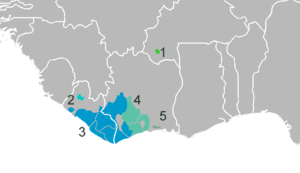Wee languages
| Kru | |
|---|---|
| Geographic distribution |
Ivory Coast, Liberia, Burkina Faso |
| Linguistic classification |
Niger–Congo
|
| Subdivisions |
|
| ISO 639-2 / 5 | |
| Glottolog |
krua1234 (Kru) siam1242 (Siamou) |

Kru languages, labeled as above
|
|
The Kru languages belong to the Niger–Congo language family and are spoken by the Kru people from the southeast of Liberia to the east of Ivory Coast. The term "Kru" is of unknown origin. According to Westermann (1952) it was used by Europeans to denote a number of tribes speaking related dialects. Marchese (1989) notes the fact that many of these peoples were recruited as "crew" by European seafarers; "the homonymy with crew is obvious, and is at least one source of the confusion among Europeans that there was a Kru/crew tribe"
Andrew Dalby noted the historical importance of the Kru languages for their position at the crossroads of African-European interaction. He wrote that "Kru and associated languages were among the first to be encountered by European voyagers on what was then known as the Pepper Coast, a center of the production and export of Guinea and melegueta pepper; a once staple African seaborne trade". The Kru languages are known for some of the most complex tone systems in Africa, rivaled perhaps only by the Omotic languages.
Recent documentation has noted "Kru societies can now be found along the coast of Monrovia, Liberia to Bandama River in Côte d'Ivoire". "Villages maintain their ties based on presumed common descent, reinforced by ceremonial exchanges and gifts". The Kru people and their languages, although now many speak English (in Liberia) or French (in Côte d'Ivoire) as a second language, are said to be "dominant in the southwest region where the forest zone reaches the coastal lagoons". The Kru people rely on the forest for farming, supplemented by hunting for their livelihood. In 2010, Kru and associated languages were spoken by 95 percent of the approximately 3.5 million people in Liberia.
The Kru languages include many subgroups such as Kuwaa, Grebo, Belle, Belleh, Kwaa and many others. According to Breitbonde, categorization of communities based on cultural distinctiveness, historical or ethnic identity, and socio-political autonomy "may have brought about the large number of distinct Kru dialects; "Although the natives were in many respects similar in type and tribe, every village was an independent state; there was also very little intercommunication". Breitbonde notes the Kru people were categorized based on their cultural distinctiveness, separate historical or ethnic identities, and social and political autonomy. This is the possible reason for so many subgroups of the Kru language. As noted by Fisiak, there is very little documentation on the Kru and associated languages.
...
Wikipedia
